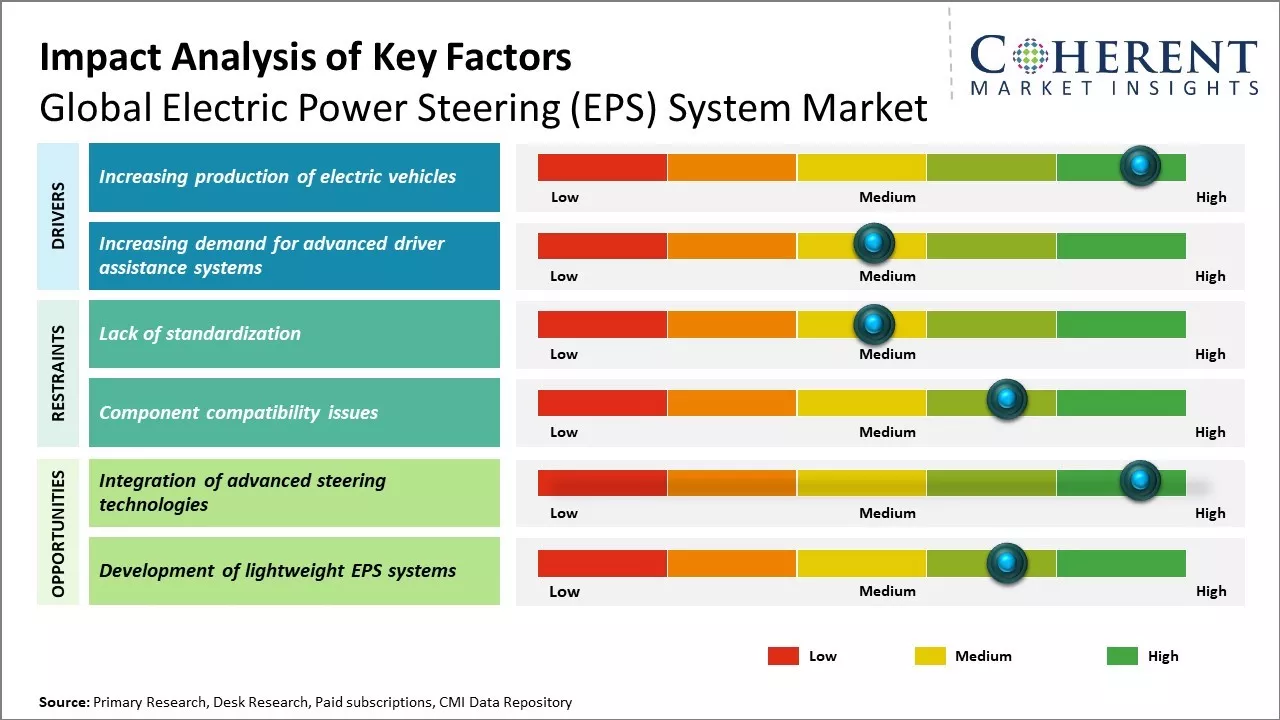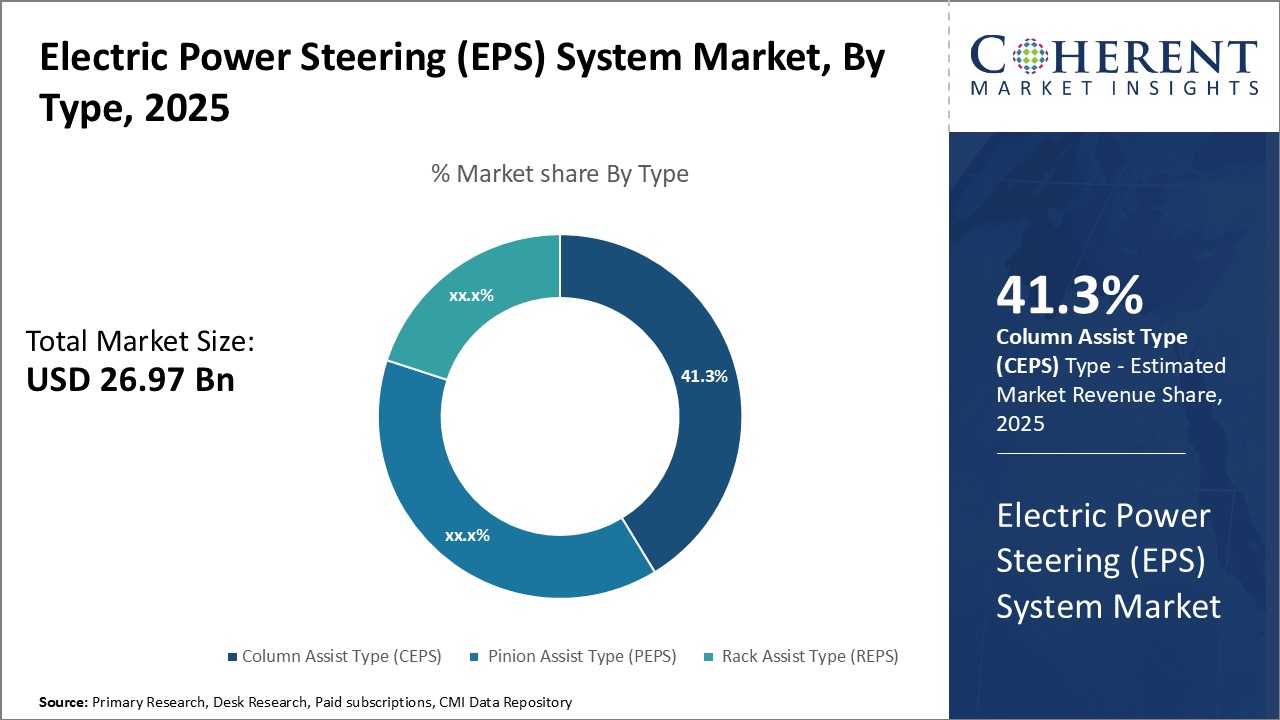The Global Electric Power Steering (EPS) System Market is estimated to be valued at US$ 26.97 Bn in 2025 and is expected to reach US$ 39.26 Bn by 2032, exhibiting a compound annual growth rate (CAGR) of 5.5% from 2025 to 2032. The growing adoption of electric vehicles across the world is driving the need for efficient steering systems in automobiles.

Discover market dynamics shaping the industry: Download Free Sample
This is attributed to factors such as growing demand for fuel-efficient and high-performance vehicles integrated with advanced steering systems. Manufacturers are focusing on developing lightweight and affordable EPS which provide better vehicle control and comfort to the driver. Government regulations regarding vehicle safety and efficiency are also driving the demand for electric power steering globally.
Drivers of the Market:
Increasing production of electric vehicles
The global automotive industry has seen rapid adoption of electric vehicles in recent years, driven mainly by stringent emission norms and push for sustainable mobility solutions. As electric vehicles do not require mechanical steering systems, the demand for electric power steering among OEMs and component manufacturers has increased tremendously. Advanced EPS systems allow automakers to better integrate electric drive components and optimize interior space in electric vehicle designs. Many new electric vehicle models now come with steer-by-wire or steer-by-motion technology which fully replaces traditional steering columns and linkages with electric actuators. This allows for creative form factors and new driving experiences.
As countries propose bans on internal combustion engines and more consumers warm up to the idea of electric mobility, analysts predicts sales of electric cars to grow exponentially in the coming years. All major and niche automakers are aggressively working to launch affordable long range electric vehicles across various segments. This rising demand base for electric cars in turn is majorly driving the need for advanced electric power steering systems that are optimized for weight, packaging and performance in electric vehicle platform designs. While mechanical power steering will still be needed for hybrids and smaller cars, electric vehicles provide a huge growth opportunity for EPS suppliers to partner with automakers and lead technology innovations in integrated steering and drivetrain solutions.

Get actionable strategies to beat competition: Download Free Sample
Increasing demand for advanced driver assistance systems
With rapid developments in automotive electronics and sensor technologies, advanced driver assistance systems that enhance safety and convenience are becoming widely adopted features across many new vehicles. Safety features like adaptive cruise control, lane keep assist, blind spot monitoring and auto emergency braking have now become expected standards. Meanwhile, next generation capabilities such as traffic jam assist, highway autopilot and automated parking are entering mainstream vehicles as well. All these driver assistance and semi-autonomous functions rely on precise control and integration of electric power steering systems with other vehicle control units and sensors. The growing consumer demand and regulatory push for advanced driver assistance pushing automakers to offer more Advanced driver assistance systems (ADAS) solutions as standard is directly fueling the electric power steering market.
Key Takeaways from Analyst:
The global Electric Power Steering (EPS) System market has significant growth potential driven by strict fuel efficiency and emission norms. Stringent government regulations regarding vehicle safety and improved driving comfort features have prompted automakers to increasingly adopt EPS over conventional hydraulic systems. EPS reduces vehicle weight and improves fuel economy by eliminating the need for costly hydraulic pumps and hoses. This will drive widespread adoption across all vehicle classes in the coming years. However, high development costs involved in integrating EPS and designing vehicles specifically for EPS may restrain market growth initially.
The North America region dominates the global Electric Power Steering (EPS) System market currently owing to high vehicle production in these countries. Increasing electrification of vehicles along with growing demand for luxury and premium vehicles augurs well for EPS adoption. Europe is also a major market riding on stringent CO2 emission norms. The U.S. market offers lucrative opportunities for EPS suppliers as consumer preference shifts toward fuel-efficient and comfortable driving experiences.
Light commercial vehicles and passenger cars are leading application segments currently but adoption in heavy commercial trucks and construction equipment is expected to increase significantly to meet fuel efficiency and emissions targets set by governments worldwide. Technology advancements in steering-by-wire and steer-by-wire systems point to new growth avenues over the long term.
Market Challenges : Lack of standardization
Lack of standardization across regions is a major hindrance for the growth of the global Electric Power Steering (EPS) System market. EPS systems and their components are currently designed and calibrated according to different vehicular and road conditions across countries and continents. This requires vehicle manufacturers to design and produce country-specific variants of EPS to meet the local regulatory safety norms and driving environments. Having distinct EPS systems for different markets significantly increases the complexity, tooling costs, and spare part inventories throughout the supply chain. It also limits the cross-border trade of EPS components between automakers and their global suppliers.
Standardizing key parameters of EPS design such as steering ratios, force feedback algorithms, sensor specifications, and calibration protocols worldwide could help address these issues. A global consensus on EPS performance and safety standards would allow manufacturers to develop standardized or more modular EPS architectures. This would simplify the design process, promote design commonality across models for economies of scale and support greater global supply chain synergies between automakers, tier 1 suppliers and component makers. However, achieving unanimity on technical specifications across diverse national and regional governing bodies continues to remain a challenge. Differences in views persist regarding the priority given to factors like vehicle dynamics, parking needs, road conditions and climatic variations which influence EPS calibration needs.
Market Opportunities: Integration of advanced steering technologies
The integration of advanced driver assistance systems and autonomous driving technologies into EPS systems presents a major growth opportunity for the global market. As technologies like adaptive cruise control, lane keep assist, autonomous emergency braking, etc. become more commonplace, the role of EPS will transform from a simple steering assist mechanism to a central component delivering configurable steering torque and force feedback based on vehicle dynamics and environmental conditions. This will allow EPS systems to work seamlessly with other advanced systems to deliver safer, more optimized driving experiences.
Systems with functions like multi-mode steering which can switch between different steering ratios automatically based on vehicle speed, road geometry, etc. will become mainstream. This will provide far greater steering control and precision to drivers. The demand for steerable front wheels on commercial vehicles is also expected to rise steadily according to estimates by the World Road Statistics database. This will require more sophisticated 4WD and all-wheel steering technologies to be integrated with EPS. Additionally, features like adjustable steering sensitivity based on driver preferences will enhance driving comfort substantially.

Discover high revenue pocket segments and roadmap to it: Download Free Sample
Insights By Type - Significant Adoption of Low-Cost Tech Boosts Electric Power Steering (EPS) System Dominance
In terms of type, the column assist type (CEPS) segment is expected to hold 41.3% share of the market in 2025 owing to its widespread adoption driven by low-cost technology. CEPS systems employ a simple rack and pinion design making them more affordable than alternatives. This ease of integration has allowed CEPS to become prevalent across small to mid-sized cars globally. Additionally, column mounted sensors in CEPS provide high accuracy in assist control relative to their size. Major automakers have also standardized on CEPS, enabling economies of scale that reduce production costs over time. CEPS systems are now suitable for various terrain conditions due to advanced sensing and Electric Control Units (ECUs). Their low-cost and widespread usage have made CEPS the core technology preferred by automakers for small to mid-sized vehicle segments.
Insights By Component - Leadership in the Steering Motor segment through a wide range of applications
In terms of component, the steering motor segment is expected to hold 38.7% share in 2025 owing to its diverse application range. Steering motors are integrated across various vehicle types from small passenger cars to heavy trucks. Their universal motor design packed with sensors provides precise assist torque for any road terrain or load condition. Additionally, next-gen Steering Motors have advanced much in accuracy, response time and energy efficiency. This has increased their utilization beyond traditional EPS into newer applications like four-wheel steering and autonomous drive assist functions. Steering motor manufacturers also offer modular designs that provide flexibility to automakers. Their capability to control multiple advance driver assistance features has created more demand for steering motors relative to other EPS components.
Insights By Vehicle Type - Passenger Vehicle Dominance from Safety and Driving Convenience
In terms of vehicle type, the passenger cars segment is expected to hold 47% share in 2025 due to consumer demand for safety and convenient driving experiences. EPS has expanded rapidly in small passenger vehicles due to its key benefits - automatic braking assistance during panic situations and easier parking in tight spots. Most importantly, EPS improves vehicle stability and handling at high speeds, providing passive safety. It has become a sought-after feature for families looking for comfort and protection during daily commutes. Luxury brands also leverage EPS to strengthen their safety credentials. Meanwhile, new functions like torque-by-wire and steer-by-wire with EPS are further enhancing passenger driving convenience. Its focus on consumer-centric values like stabilization and ease-of-use has made EPS systems a favorite in the growing passenger vehicles industry worldwide.

Need a Different Region or Segment? Download Free Sample
North America has dominated the global Electric Power Steering (EPS) System market. The region is expected to account for 41.3% of the market share in 2025 due to strong automobile industry presence and early adoption of advanced automotive technologies in the region. The U.S. market has witnessed rapid electrification of steering systems as leading American automakers actively make their fleets fuel efficient and modern. With new vehicle markets in the U.S. and Canada relying heavily on pickup trucks and SUVs, North American EPS manufacturers have maintained an edge through technology innovations that enhance driving dynamics of such large vehicles.
Europe has also been an important EPS market led by Germany, France, and the U.K. European automakers aim to reduce emissions from all source including auxiliary automotive components. This has driven EPS system adoption across most vehicle segments including economy cars. Strong presence of global automotive suppliers has made EPS systems easily available to both mainstream and luxury vehicle brands. However, pricing pressures in economy vehicles may impact future demand growth from Europe.
The fastest growing regional market has been Asia Pacific with China and India at the forefront. As APAC becomes the largest automobile hub, local EPS manufacturers are ramping up capacities and collaborating with overseas technology players. This has lowered EPS system costs for small cars which see maximum sales volume in the region. Additionally, growing demand for mid-size SUVs and crossovers in Asia has attract foreign investments towards developing EPS optimized for emerging consumer preferences. Rapid motorization of smaller cities and towns continues to stimulate aftermarket sales across APAC as well.
With automakers focusing more on optimized vehicle weight and performance, EPS systems are expected to remain integral to new product development worldwide. Regional performances will thus vary depending on how macroeconomic and industry trends support continued adoption within diverse automotive and aftermarket channels. Consolidation among global suppliers may also impact competitive dynamics across key Electric Power Steering (EPS) System market.
Electric Power Steering (EPS) System Market Report Coverage
| Report Coverage | Details | ||
|---|---|---|---|
| Base Year: | 2024 | Market Size in 2025: | USD 26.97 Bn |
| Historical Data for: | 2020 To 2024 | Forecast Period: | 2025 To 2032 |
| Forecast Period 2025 to 2032 CAGR: | 5.5% | 2032 Value Projection: | USD 39.26 Bn |
| Geographies covered: |
|
||
| Segments covered: |
|
||
| Companies covered: |
Alcatel-Lucent (Nokia Networks), Bosch, DENSO Corporation, Hitachi Astemo (Showa), Hyundai Mobis, JTEKT Corporation, Mando Corporation, Mitsubishi Electric Corporation, Nexteer Automotive, NSK Global, Robert Bosch GmbH, Thyssenkrupp Presta AG, Valeo S.A., ZF Friedrichshafen AG, and Zhuzhou Elite Electro-Mechanical Co. Ltd. |
||
| Growth Drivers: |
|
||
| Restraints & Challenges: |
|
||
Uncover macros and micros vetted on 75+ parameters: Get instant access to report
*Definition: The Global Electric Power Steering (EPS) System Market involves companies that manufacture electric power steering systems for use in modern automobiles. These electric systems assist drivers by controlling the steering and making it lighter and smoother. They use an electric motor to provide steering assistance rather than relying solely on the driver's upper body strength. This has increased popularity due to benefits like improved fuel efficiency and safety.
Share
Share
About Author
As an accomplished Senior Consultant with 7+ years of experience, Pooja Tayade has a proven track record in devising and implementing data and strategy consulting across various industries. She specializes in market research, competitive analysis, primary insights, and market estimation. She excels in strategic advisory, delivering data-driven insights to help clients navigate market complexities, optimize entry strategies, and achieve sustainable growth.
Missing comfort of reading report in your local language? Find your preferred language :
Transform your Strategy with Exclusive Trending Reports :
Frequently Asked Questions
Joining thousands of companies around the world committed to making the Excellent Business Solutions.
View All Our Clients